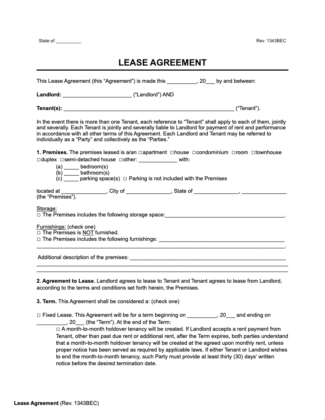
Use our standard residential lease agreement to set out the essential details of the landlord-tenant relationship.

Updated June 17, 2024
Written by Ioana Gagiuc | Reviewed by Susan Chai, Esq.
A standard residential lease agreement is a binding contract between a landlord and tenant, detailing tenancy terms for a residential property. It covers rent details, security deposit, maintenance guidelines, and rules for lease termination, property damage, and modifications.
Such leases typically last one year, ensuring landlords receive regular rental income and tenants have the right to occupy the premises under specified conditions. This document promotes clarity and transparency, minimizing disputes by clearly outlining each party’s responsibilities. Residential leases apply to various types of living spaces, including single-family homes, apartments, and more.
Landlords and property managers should conduct a diligent tenant screening process to select the best tenants for the property. This involves two critical steps:
There are two primary types of residential leases:
A month-to-month lease is less common but is used frequently in landlord-tenant situations:
The required termination period may vary from state to state, so make sure to check the month-to-month termination laws.
Understanding the specifics of lease termination for residential lease agreements helps both landlords and tenants navigate the process effectively:
Follow these tips below to help you write your agreement:
The lease should identify each party to the contract. The first party is the landlord. They could be an individual or a business entity.
The second party is the tenant; the agreement may list multiple tenants. Children and people not listed as tenants but living on the property are named occupants.
The lease should clearly describe the premises, specifying whether it is a single-family home, apartment, condo, or another property type. If it involves amenities or other available services, these features should be precisely detailed and included in the document.
The contract should provide specific details about the premises:
The lease agreement must define the term. For a fixed-term lease, provide the start and end dates in a mm/dd/yyyy format. The parties may choose to extend the lease term with a lease extension agreement, or a month-to-month tenancy may be created at the end of the term.
In the case of a month-to-month tenancy, the agreement should define the first day the tenant may occupy the premises and state that the rental agreement will continue every month after that date until either party terminates.
The agreement must list the specific amount of rent and how often it is due. In most residential leases, tenants pay rent monthly. However, how a landlord charges rent is up to them.
Before establishing the rent amount, conducting a final assessment of the neighborhood is advisable to compare the monthly rent offered by other landlords. RentoMeter uses third-party resources to provide prospective tenants with the median rent in the market area, helping them determine if they might be overpaying.
In the rent amount section, other important details to add are:
Late fees are typically charged per day of delayed payment or occurrence. Several states have imposed maximum limits, so it’s a good idea to research the applicable laws in the property’s location.
The lease should outline whether utilities are included in the rent. If they are not, the lease should detail how the tenant should set them up. It might mention which company to contact or other vital details. The lease may also make the tenant responsible for utility services, which may include:
The lease should describe what furnishings come with the rental premises. This section should also address a rental inspection checklist. A tenant can complete this checklist to examine the presence and condition of the furnishings and if there is any preexisting damage to the property.
Most lease agreements require the tenant or landlord to deliver a specific amount of notice before ending the tenancy. This is typically one month’s notice before termination. However, it may have a longer duration.
It should detail what happens if the tenancy is terminated early, including any consequences for the early breach. A lease addendum can prove helpful when modifying the original lease agreement.
The agreement should contain standard policies and disclosures, such as:
The landlord and all adult tenants should sign the lease. The lease template must have a section where parties sign and print their name and another to date their signature.
An authorized agent or officer should sign for the company if the landlord is a business entity. The landlord agent should also note their official title immediately behind their name.
You can download your standard residential lease agreement template below in PDF and Word.